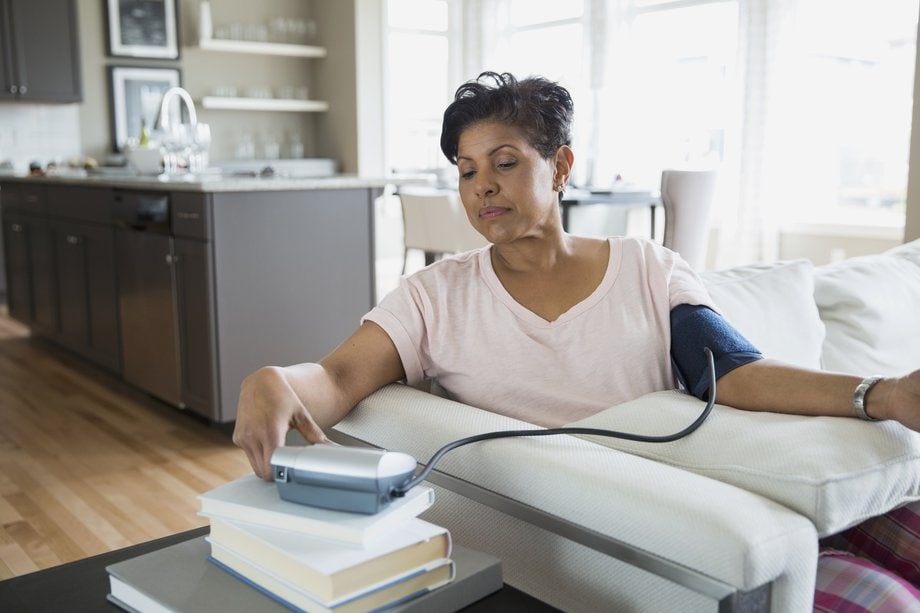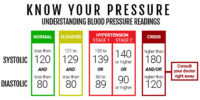How To Monitor Blood Pressure At Home?

High blood pressure, also known as hypertension, is a common health condition that can lead to serious complications if left untreated. Monitoring blood pressure at home is an effective way for individuals to track their blood pressure levels and make necessary lifestyle changes.
This article provides a comprehensive guide on how to monitor blood pressure at home. It begins by explaining the significance of understanding blood pressure levels and choosing the appropriate blood pressure monitor.
The article then discusses the importance of proper preparation and technique for measuring blood pressure accurately. Additionally, it outlines the process of interpreting blood pressure readings and keeping a blood pressure log.
Finally, the article highlights the lifestyle changes that can help manage blood pressure and when it is necessary to seek medical assistance. By following the guidelines presented in this article, individuals can take control of their blood pressure and improve their overall health.
Key Takeaways
- Home blood pressure monitoring is important for tracking and managing blood pressure levels.
- Proper technique and correct usage of a blood pressure monitor are essential for accurate readings.
- Lifestyle modifications, such as exercise and a healthy diet, play a crucial role in maintaining normal blood pressure.
- Regular check-ups with a healthcare professional and consistent medication adherence are important for effective high blood pressure management.
Understanding Blood Pressure Levels
Understanding blood pressure levels is crucial for individuals to maintain their health and prevent the development of serious cardiovascular conditions.
Blood pressure is the force exerted by the blood against the walls of the arteries as the heart pumps it around the body.
Normal blood pressure is typically around 120/80 mmHg, with the top number (systolic pressure) representing the pressure when the heart contracts and the bottom number (diastolic pressure) representing the pressure when the heart relaxes.
High blood pressure, or hypertension, is defined as having a blood pressure reading consistently above 130/80 mmHg.
It is important to monitor blood pressure at home regularly to detect any abnormalities and take necessary steps to manage and control it.
Maintaining a healthy lifestyle, such as regular exercise, a balanced diet, and stress management, can help regulate blood pressure levels and reduce the risk of cardiovascular diseases.
Choosing the Right Blood Pressure Monitor
To effectively select an appropriate device for self-measurement, it is crucial to consider the accuracy, ease of use, and reliability of the blood pressure monitoring equipment.
Blood pressure accuracy is of utmost importance as it directly affects the reliability of the readings. There are different types of blood pressure monitors available in the market, including manual and digital monitors. Manual monitors require the use of a stethoscope and are typically used by healthcare professionals.
On the other hand, digital monitors are more commonly used by individuals at home due to their ease of use. Digital monitors can further be divided into automatic and semi-automatic monitors. Automatic monitors inflate the cuff and measure the blood pressure automatically, while semi-automatic monitors require the user to inflate the cuff manually.
It is essential to choose a monitor that suits individual needs and preferences while ensuring accurate readings.
Preparing for the Measurement
Before measuring your blood pressure, it is important to properly prepare yourself to ensure accurate and reliable results.
One crucial aspect of preparation is ensuring that you have the necessary equipment. This includes a blood pressure monitor that is suitable for home use. It is essential to choose a monitor that has been validated for accuracy by reputable organizations. Additionally, make sure that the monitor has the appropriate cuff size for your arm circumference, as an ill-fitting cuff can lead to inaccurate readings.
Another important aspect of preparation is correct positioning. To obtain accurate measurements, it is recommended to sit in a comfortable chair with your back supported and feet flat on the ground. Your arm should be positioned at heart level, so consider using a table or armrest to support it. It is crucial to avoid crossing your legs or talking during the measurement, as these actions can affect the accuracy of the results.
By properly preparing yourself and following these guidelines, you can ensure accurate and reliable blood pressure measurements at home.
Proper Technique for Measuring Blood Pressure
Proper Technique for Measuring Blood Pressure:
Optimal positioning, including sitting in a supported chair with feet flat on the ground and arm at heart level, is crucial for obtaining accurate and trustworthy measurements at home.
Maintaining correct posture ensures the blood pressure readings are not influenced by external factors. Sitting with the back straight and supported, and avoiding crossing the legs or slouching, allows for an accurate measurement.
Additionally, using the recommended cuff size is essential for obtaining reliable results. The cuff should fit snugly around the upper arm, with the bladder centered over the brachial artery. A cuff that is too small may result in falsely elevated readings, while a cuff that is too large may yield falsely low measurements.
Therefore, adhering to the correct posture and using the appropriate cuff size are vital steps in obtaining accurate blood pressure measurements at home.
Interpreting Blood Pressure Readings
Interpreting blood pressure readings accurately requires understanding the significance of the numbers and their correlation to hypertension and cardiovascular health. It is important to interpret blood pressure trends over time rather than focusing on individual readings. By tracking blood pressure variations, healthcare professionals can identify patterns and determine the effectiveness of treatment plans.
There are several key factors to consider when interpreting blood pressure readings:
- Systolic and diastolic pressure: The top number (systolic) represents the pressure in the arteries when the heart contracts, while the bottom number (diastolic) signifies the pressure when the heart is at rest.
- Normal and abnormal ranges: Blood pressure readings are classified into different categories, including normal, elevated, hypertension stage 1, and hypertension stage 2.
- Trend analysis: Evaluating blood pressure trends over time allows for a better understanding of a person’s overall cardiovascular health and the effectiveness of interventions.
By understanding these aspects, individuals and healthcare professionals can make informed decisions regarding blood pressure management and improve overall cardiovascular health.
Keeping a Blood Pressure Log
In order to accurately track and analyze blood pressure variations over time, maintaining a detailed log of readings is essential. This log can provide valuable insights into blood pressure patterns, aid in the identification of potential triggers, and help healthcare professionals make informed decisions regarding treatment options. A blood pressure log typically consists of columns for date, time, systolic pressure, and diastolic pressure. By recording this information regularly, individuals can identify trends and fluctuations, providing a comprehensive overview of their blood pressure status. Additionally, this log can be a useful tool for monitoring the effectiveness of blood pressure medication or alternative therapies. It allows individuals to assess the impact of lifestyle changes, such as diet and exercise, on their blood pressure levels and make necessary adjustments accordingly.
Lifestyle Changes to Manage Blood Pressure
Transitioning from the previous subtopic of keeping a blood pressure log, it is important to complement this practice with lifestyle changes to effectively manage blood pressure levels.
Dietary modifications play a crucial role in maintaining a healthy blood pressure. Consuming a diet rich in fruits, vegetables, whole grains, and low-fat dairy products while limiting sodium, saturated fats, and cholesterol intake can significantly reduce blood pressure.
Additionally, implementing stress management techniques can have a positive impact on blood pressure levels. Engaging in regular physical activity, practicing relaxation techniques such as deep breathing or yoga, and ensuring an adequate amount of sleep can help manage stress and contribute to maintaining a healthy blood pressure.
By incorporating these lifestyle changes, individuals can take an active role in monitoring and managing their blood pressure at home.
When to Seek Medical Help
Seeking medical help is necessary when individuals experience persistently high blood pressure levels despite lifestyle changes and self-care measures. It is important to be aware of the signs that may indicate the need for medical attention.
One of the signs of high blood pressure is having consistently elevated readings, even after implementing lifestyle modifications. Additionally, if individuals experience symptoms such as severe headaches, shortness of breath, chest pain, or dizziness, it is crucial to seek medical assistance. These symptoms may indicate a more serious underlying condition that requires immediate attention.
Furthermore, if individuals have a family history of high blood pressure or other cardiovascular diseases, it is advisable to consult a healthcare professional for proper evaluation and management. Early detection and appropriate medical intervention can help prevent complications associated with high blood pressure.
Frequently Asked Questions
Are there any alternative methods for monitoring blood pressure at home besides using a blood pressure monitor?
Alternative methods for monitoring blood pressure at home, besides using a blood pressure monitor, include wearable devices, smartphone apps, and smartwatches. However, their accuracy may vary, and it is important to consider their convenience and affordability when choosing these alternatives.
Can stress or anxiety affect blood pressure readings?
Stress and anxiety can indeed affect blood pressure readings. Effective stress management and adopting a healthy lifestyle can help mitigate their impact on blood pressure, ensuring more accurate readings and reducing the risk of false high readings.
Is it normal for blood pressure readings to fluctuate throughout the day?
Blood pressure readings can fluctuate throughout the day due to various factors affecting blood pressure, including physical activity, stress levels, and time of day. Understanding blood pressure patterns is important for accurate monitoring and management.
How often should blood pressure be monitored at home?
The frequency of blood pressure monitoring at home depends on individual circumstances such as medical history and risk factors. Regular accuracy assessment should be conducted to ensure reliable measurements and appropriate management of hypertension.
Can the use of certain medications or supplements affect blood pressure readings?
The use of certain medications and dietary supplements can have an impact on blood pressure readings. It is important to be aware of these potential effects and consult with a healthcare professional for accurate monitoring.








